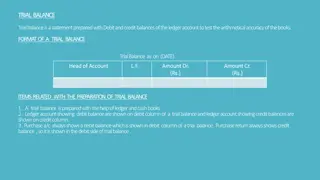Understanding Debit and Credit in Accounting
Debit and credit are fundamental concepts in accounting that help record business transactions accurately. Debits increase assets or expenses and decrease liabilities or equity, while credits do the opposite. The rules of debit and credit ensure that accounting entries are balanced, with each transaction impacting at least two accounts. The three golden rules of accounting guide how entries are recorded based on the type of account involved, whether real, personal, or nominal. By following these principles, businesses can maintain accurate financial records.
Download Presentation

Please find below an Image/Link to download the presentation.
The content on the website is provided AS IS for your information and personal use only. It may not be sold, licensed, or shared on other websites without obtaining consent from the author. Download presentation by click this link. If you encounter any issues during the download, it is possible that the publisher has removed the file from their server.
E N D
Presentation Transcript
Debit and Credit in Accounting Every business transaction which can be measured in monetary terms finds a place in the accounting transactions of a firm. In order to record such transactions, a system of debit and credit has been devised, which records such events through two different accounts. The net effect of these accounting entries is the same in terms of quantity. However, by debiting and crediting two different accounts, the correct and apt accounting treatment can be depicted. In a ledger account, usually the debit column is on the left and the credit column is on the right.
A debit is an accounting entry that either increases an asset or expense account. Or decreases a liability or equity account. It is positioned on the left in an accounting entry. A credit is an accounting entry that increases either a liability or equity account. Or decreases an asset or expense account. It is positioned on the right in an accounting entry.
Whenever an accounting transaction happens, a minimum of two accounts is always impacted, with a debit entry being recorded against one account and a credit entry being recorded against another account. There is no upper limit to the number of accounts involved in a transaction but the minimum cannot be less than two accounts. The totals of the debits and credits for any transaction must always equal each other so that an accounting transaction is always said to be in balance. Thus, the use of debits and credits in a two column transaction recording format is the most essential of all controls over accounting accuracy. This is how debit and credit find their use.
3 Golden Rules of Accounting Golden rules of account form the basis for bookkeeping. As per the golden rules of accounting, you must ascertain the type of account for each transaction. Each type of account has its own set of rules that needs to be applied for each transaction. Following are the three golden rules of accounting:
Rule 1: Debit What Comes In, Credit What Goes Out. This rule applies to real accounts. Furniture, land, buildings, machinery, etc., are included in real accounts. By default, they have a debit balance. As a result, debiting what is coming in adds to the existing account balance. Similarly, when a tangible asset leaves the firm, crediting what goes out reduces the account balance.
Rule 2: Debit the Receiver, Credit the Giver. This rule applies to personal accounts. When a real or artificial person donates something to the organisation, it becomes an inflow, and the person must be credited in the books. Conversely, the receiver must be debited.
Rule 3: Debit All Expenses and Losses, Credit all Incomes and Gains. This rule applies to nominal accounts. A company s capital is its liability. As a result, it has a credit balance. Crediting all the income and gains will increase the capital. On the other hand, the capital reduces when expenses and losses are debited.























